
Swede: sowing, cultivation, harvest
Contents
The swede in a nutshell
- The swede is a very ancient root vegetable with dense flesh, highly nutritious from a dietary perspective
- Its tuberised and swollen root can be eaten cooked, or raw and thinly sliced in salads
- It originates from cross-breeding between cabbage and turnip, but its flavour is more refined than these, with a pronounced hazelnut taste
- Swede is also used as fodder to feed livestock
- Easy to grow in sunny locations with fresh, well-drained soil, swede is hardy and thrives in cold, damp climates
- In Ireland and Scotland, the roots of swedes are hollowed out to make Halloween lanterns
Our expert's word
Highly Productive Heritage Vegetable originating in Scandinavia at the end of the Middle Ages, the swede, Brassica napus var. napobrassica, is one of those forgotten species, like the Jerusalem artichoke, which suffered from its reputation as a “wartime vegetable”. Its delicate flavour, more subtle than that of turnips and cabbages, deserves to be rediscovered today.
The swede is the result of cross-breeding between Brassica oleacea (ancestor of the cabbage) and Brassica napus (the turnip). It is mainly eaten cooked in the same way as potatoes, or in winter stews and casseroles to which it lends its distinctive flavour with pronounced nutty notes. Rich in fibre and potassium, the swede is a highly nutritious plant that offers many medicinal benefits.
The swede thrives in the vegetable garden in sunny positions, away from other brassicas. Hardy and easy to grow, it requires however a well-drained soil, consistently cool and moist. It is sown under cover or directly in spring for an autumn harvest, sometimes extending into winter.
Biennial, it produces melliferous flowering which attracts pollinators. However, this generally only occurs during the swede’s second year of growth.
Here are all our tips on this exceptionally nutritious vegetable.
Description and botany
Botanical data
- Latin name Brassica napus var. napobrassica
- Family Brassicaceae
- Common name Swede, Swedish turnip, Rutabaga
- Flowering June
- Height 30 to 50 cm
- Exposure sunny
- Soil type well-drained, deep, fertile, rich and humus-bearing
- Hardiness -10°C to -20°C
The rutabaga, also known as swede, Swedish turnip or neep is a root vegetable cultivated as a highly nutritious kitchen garden plant. It belongs to the large Brassicaceae family (formerly called Cruciferae) alongside turnips, cabbages, radishes, mustard, and wallflowers. The rutabaga originates from Northern Europe.
Over forty varieties of rutabaga are listed in the European catalogue, with three in the French catalogue. Among the best-known round-rooted varieties on our plates, you’ll find the Champion rutabaga, the Wilhemsburger rutabaga, the yellow Saint-Marc, or the white Aubigny. Although some varieties are often reserved for cattle fodder, all are actually excellent for human consumption when young.
Brassica napus var. napobrassica is a biennial plant considered a root vegetable, although its edible part is more accurately a hypocotyl (the part of the stem below the cotyledons). This thickens to form an average pear-shaped bulb 12 cm in diameter, swollen and almost entirely concealed in the soil, with only the collar emerging above ground. The edible part of the plant is typically coloured green or red on its upper half.
The deciduous foliage of the swede forms a rosette atop the hypocotyl. The leaves are long and deeply lobed, very similar to turnip leaves, though unlike turnips they are not pubescent (hairy).
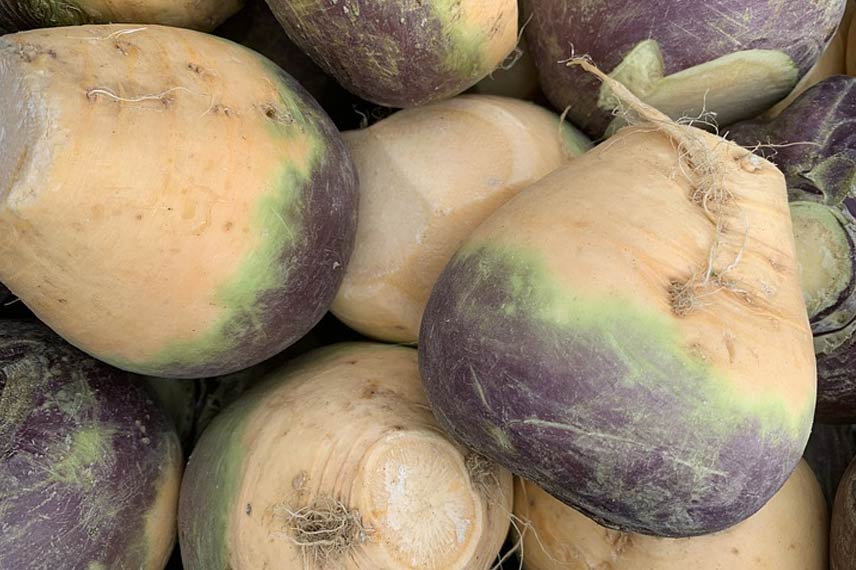
As a melliferous plant, flowering in rutabagas typically occurs during the second year of growth. It then produces small yellow-petalled flowers, arranged in terminal clusters.
Rich in vitamin C, fibre and mineral salts, the rutabaga offers numerous nutritional benefits.
Main varieties of swedes

Champion Rapeseed (yellow with red collar) - Vilmorin seeds - Brassica napus
- Height at maturity 30 cm

Wilhemsburger Rapeseed (with green neck) - Vilmorin seeds - Brassica napus
- Height at maturity 30 cm

Wilhemsburger Rapeseed (with green neck) - Vilmorin seeds - Brassica napus
- Height at maturity 30 cm
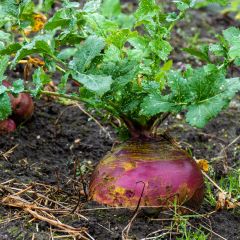
Swede Magres - Rutabaga
- Height at maturity 30 cm

Swede Brora - Rutabaga
- Height at maturity 30 cm
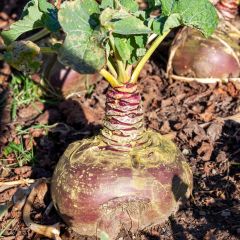
Swede Tweed F1 - Rutabaga
- Height at maturity 30 cm
Discover other Swede
View all →Available in 1 sizes
Available in 1 sizes
Available in 1 sizes
Available in 1 sizes
Cultivation, Care and Maintenance of Swede
While it tolerates partial shade, the swede prefers sunny positions.
A root vegetable ideal for cold and damp climates, the swede is a hardy vegetable plant capable of withstanding frost and temperatures around -20°C, provided however that the soil is well-drained. A soil it appreciates deep, fertile, rich and humus-bearing. On the other hand, it’s best to avoid growing it in poor and chalky soil.
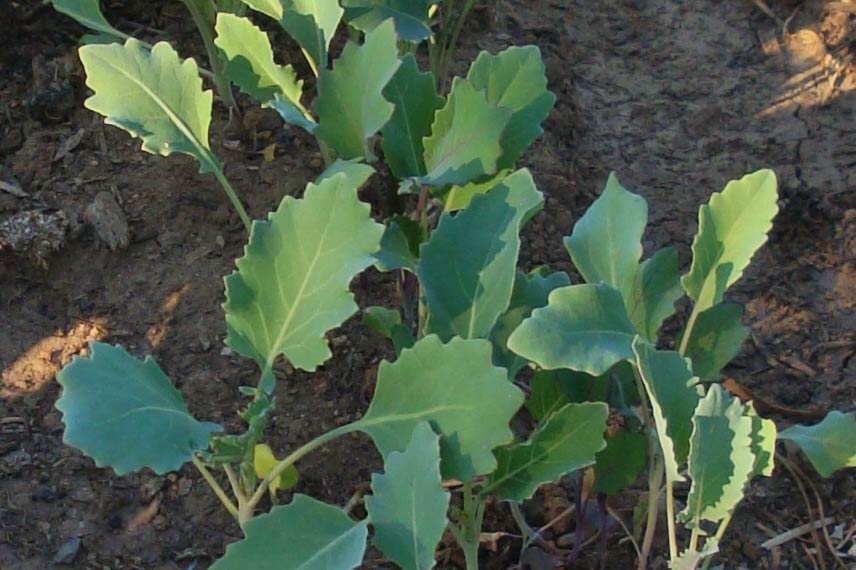
Swede cultivation © Eileen Kane – Flickr
Easy to grow once established, the swede is a plant that requires little maintenance and care to thrive. Even with minimal care, the swede reaches ripeness easily.
The swede is thirsty for water. Watering should be regular, but the soil should never be waterlogged. Mulching around the base with dried leaves or grass clippings helps maintain soil moisture and keeps it cool during summer.
Remember to weed and hoe regularly around your young plants of swede to allow water to penetrate the soil well and limit weed proliferation.
For swedes left in the ground during winter, earth up the base in autumn and apply a mulch of leaves to protect from frost.
When and how to sow swede?
When to Sow?
Sowing of swede turnips is carried out under cover in early spring (March-April), or directly in situ in late spring to early summer (May to July).
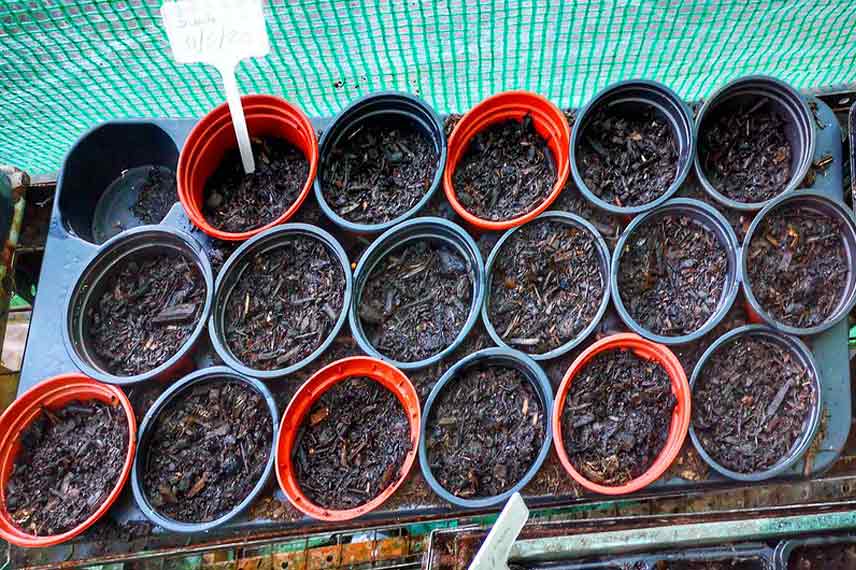
Swede turnip sowing © Hefin Owen – Flickr
Sowing Under Cover
- Sow under cover from 15°C
- Sow in trays or buckets filled with a humus-rich, well-draining substrate
- Bury the seeds of swede turnip 1 to 2 cm deep
- Lightly cover the seeds
- Firm down and water with a fine spray to lightly moisten the substrate
- Germination occurs after about 10 days
- Thin out the young plants to 7 cm when they have 2 to 3 leaves
Transplanting Young Plants from Under Cover
Sowing carried out under cover is transplanted in situ between the months of May and June.
- Choose a sunny or partially shaded location
- Transplant the young plants when they have 3 or 4 leaves
- Space the plants 30 to 40 cm apart in all directions
- Water regularly without waterlogging the soil
- Mulch the base to retain soil moisture and coolness
- Hoe regularly
Sowing In Situ
- Choose preferably a sunny location
- Turn over the soil to a depth of 20 cm
- Amend the soil with compost
- Sow in rows 30 cm apart on the same rank
- Press the seeds 2 cm deep
- Water with a fine spray without waterlogging
- Germination occurs after about ten days
Harvest, storage and uses of swede
Harvest
Swedes are harvested as needed from late summer to autumn (September to November), and sometimes even into the heart of winter (February). It’s worth noting that the swede is much more tender and flavoursome when harvested before full ripeness. Proceed by uprooting the plants, preferably in dry weather.
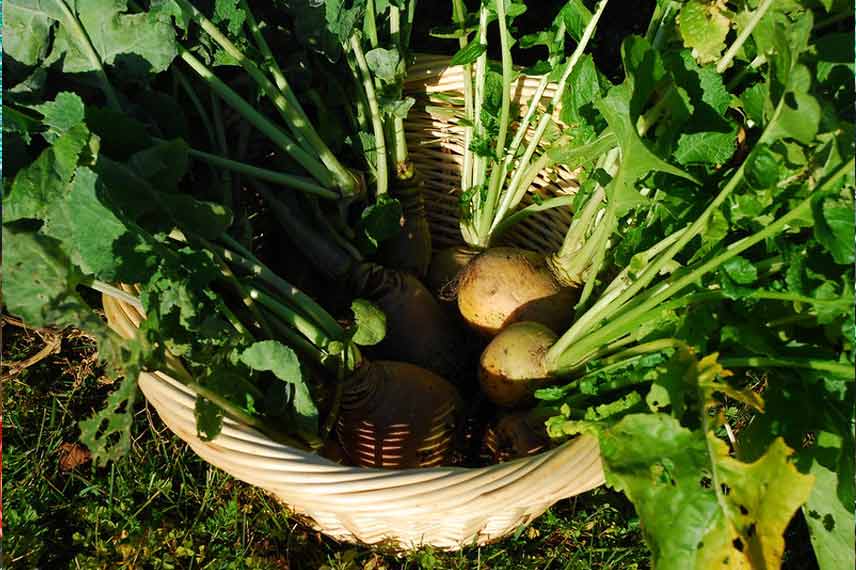
Swede harvest © Johnathan Nightingale – Flickr
Note: A swede is ready to harvest when it feels firm and heavy. Yields are estimated at around 4 kg per m².
Storage
The swede is a hardy root vegetable that can be left in the ground until February. However, harvesting may become more difficult during prolonged frosts. Winter swedes can be left in the ground until March provided they were sown as late as possible.
Once harvested, it’s best stored in a clamp in a cellar, buried in sand or turf where temperatures don’t exceed 10°C. It can also be kept in a cool, dark room.
In the refrigerator, the swede will keep for a few days in the vegetable drawer.
Uses
- Forage use
Forage varieties of swede are used to feed cattle and sheep at pasture. It’s particularly favoured by horses. Only the foliage and above-ground portion of the hypocotyl are used in this case.
- In cooking
Lighter than turnips, the swede is particularly appreciated in cooking for its pronounced hazelnut flavour.
It’s most often cooked, just like potatoes, as mash, in gratins, or fried.
Swedes also pair very well with winter vegetables like turnips and carrots. They cleverly accompany traditional winter stews, particularly pot-au-feu.
Note: The thickness of swede flesh makes it difficult to peel with a vegetable peeler. It’s better to use a knife rather than a peeler.
- Medicinal properties
Swedes are reputed to be very rich in fibre and potassium. This composition makes them a good diuretic and may reduce risks of hypo-citraturia. The diuretic properties of swedes may help combat high blood pressure and heart failure.
Swedes are also credited with laxative, digestive and remineralising properties.
Note: Like all plants in the Brassica genus, swedes may promote the development of simple goitres (benign thyroid enlargement).
Potential diseases and pests of swede
Swedes can be susceptible to various diseases.
- Alternaria leaf spot, or Alternaria blight, refers to a series of fungal diseases caused by fungi of the Alternaria or Ulocladium genera.
- Clubroot, a fungal disease caused by a myxomycete protist, a microscopic fungus from the Plasmodiophoraceae family.
- Blight, a fungal disease caused by a pathogenous fungus, Phytophthora infestans, which develops mainly in humid weather between 17 and 20°C.
- Powdery mildew, also called white rot or white mould, which refers to a series of fungal diseases caused by the asexual form of certain ascomycete fungi.
In terms of pests, swedes can be attacked by various harmful insects such as flea beetles, gall midges, weevils, cabbage flies, cutworms and cabbage whites.
Gastropods, slugs and snails, are also fond of swede leaves.
To protect your swedes from disease risks and pests, certain preventive measures can be taken:
- To combat cabbage flies or flea beetles, remember to remove the roots from the soil at the beginning of August.
- Alternate crops in the vegetable garden to avoid powdery mildew and root rot.
- By weeding regularly and mulching the soil, you will also prevent the proliferation of certain pests.
Propagation of swede
As we’ve seen previously, swede propagation is done by sowing under cover between March and April, or directly in situ between May and July, when all risk of frost has passed.
It’s best to purchase swede seeds from a reputable supplier. Indeed, harvesting the seeds is particularly challenging with swedes, as they are biennial plants that will only flower if left in the ground throughout winter.
Pairing swedes in the vegetable garden
Swedes enjoy the company of many other vegetable plants, such as lettuces, carrots, celery, mint, broad beans, or even beans.
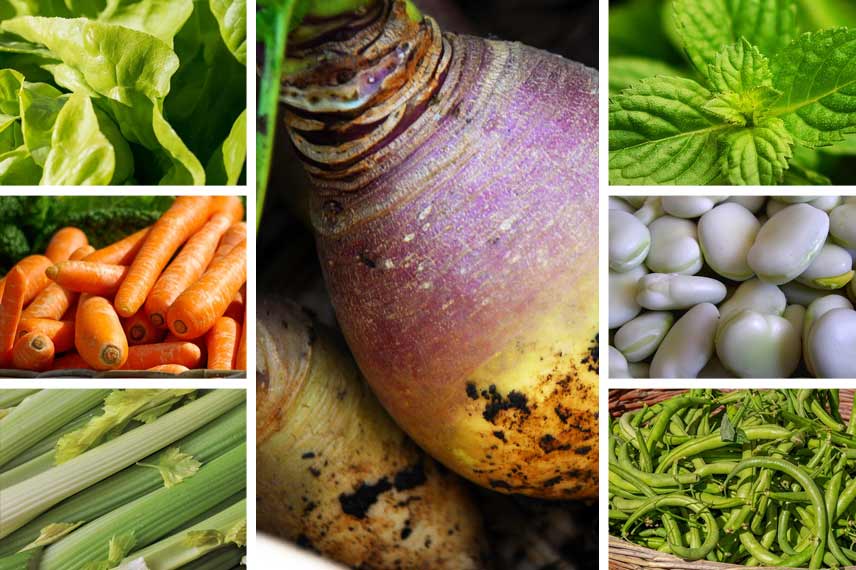
1.Lettuce 2.Carrots 3.Celery 4.Swede 5.Mint 6.Broad beans, 7.Beans
However, to avoid potential mineral imbalance in the soil, avoid planting near other Brassicaceae (radishes, turnips, cabbages, broccoli…). Similarly, do not sow your swedes where you previously grew other Brassicaceae. It’s also preferable to wait a few years before replanting swedes in the same spot in your vegetable garden.
Useful resources
- To learn more, check out our guide on storing your vegetable garden harvest.
- Discover other heritage vegetables to grow in your garden.
- Learn more about companion planting in vegetable gardens.
- Finally, explore our selection of swedes available at promesse de fleurs.
- Subscribe!
- Contents

































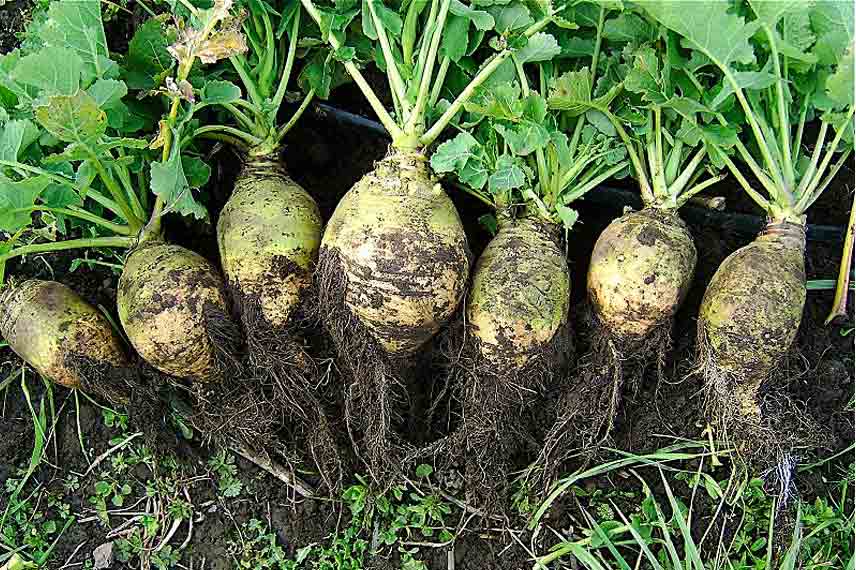

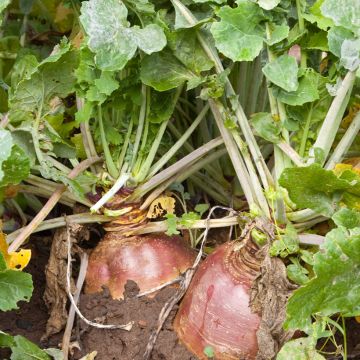

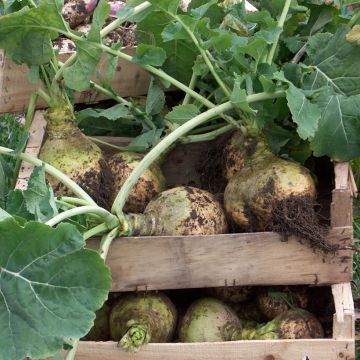


Comments